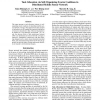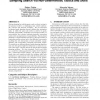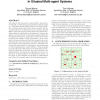170 search results - page 9 / 34 » Measuring Agent Intelligence via Hierarchies of Environments |
AAAI
2004
13 years 10 months ago
2004
This paper presents a task allocation scheme via selforganizing swarm coalitions for distributed mobile sensor network coverage. Our approach uses the concepts of ant behavior to ...
ATAL
2009
Springer
13 years 10 months ago
2009
Springer
Motion planning for mobile agents, such as robots, acting in the physical world is a challenging task, which traditionally concerns safe obstacle avoidance. We are interested in p...
AAAI
1996
13 years 10 months ago
1996
Procedural representations of control policies have two advantages when facing the scale-up problem in learning tasks. First they are implicit, with potential for inductive genera...
ATAL
2000
Springer
14 years 1 months ago
2000
Springer
In this paper, we describe a framework to program open societies of concurrently operating agents. The agents maintain a subjective theory about their environment and interact with...
ATAL
2003
Springer
14 years 2 months ago
2003
Springer
According to the taxonomy for agent activity, proposed by V. Parunak, a collaboration is an interaction between agents of a multi-agent system (MAS) whereby the agents explicitly ...



